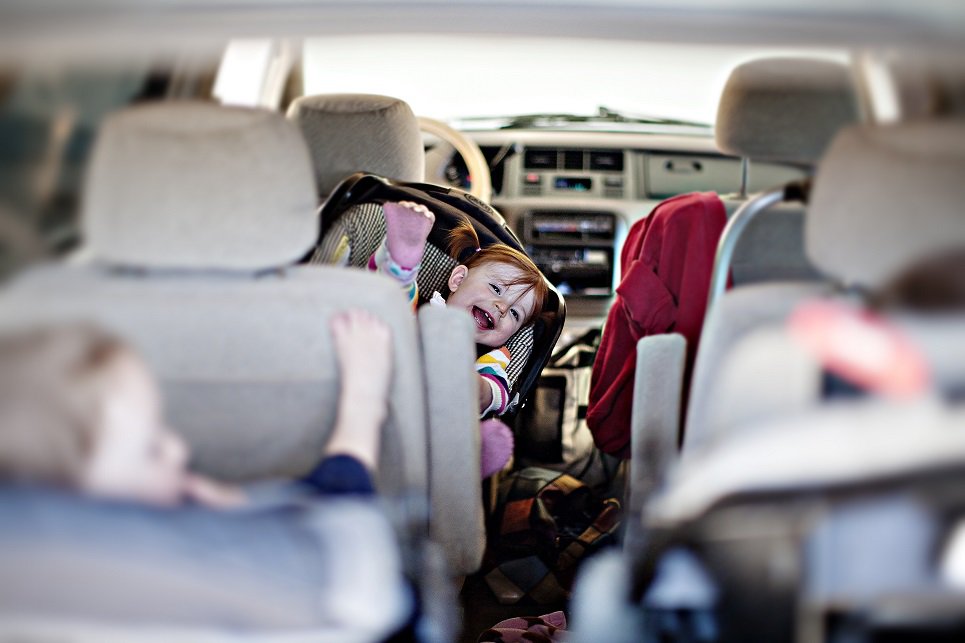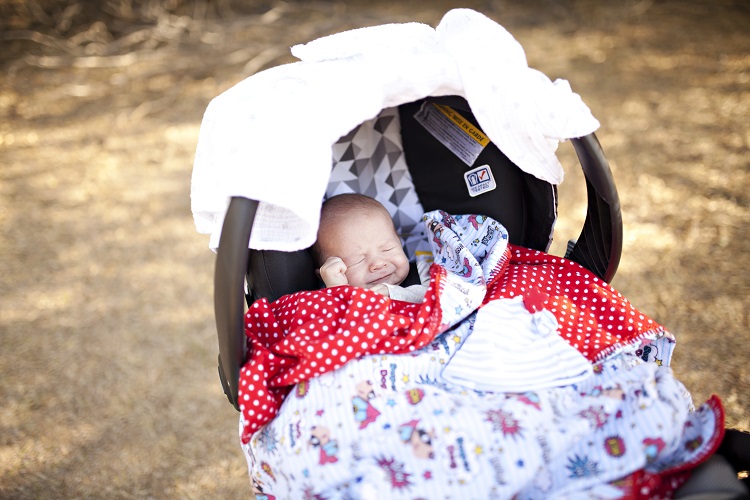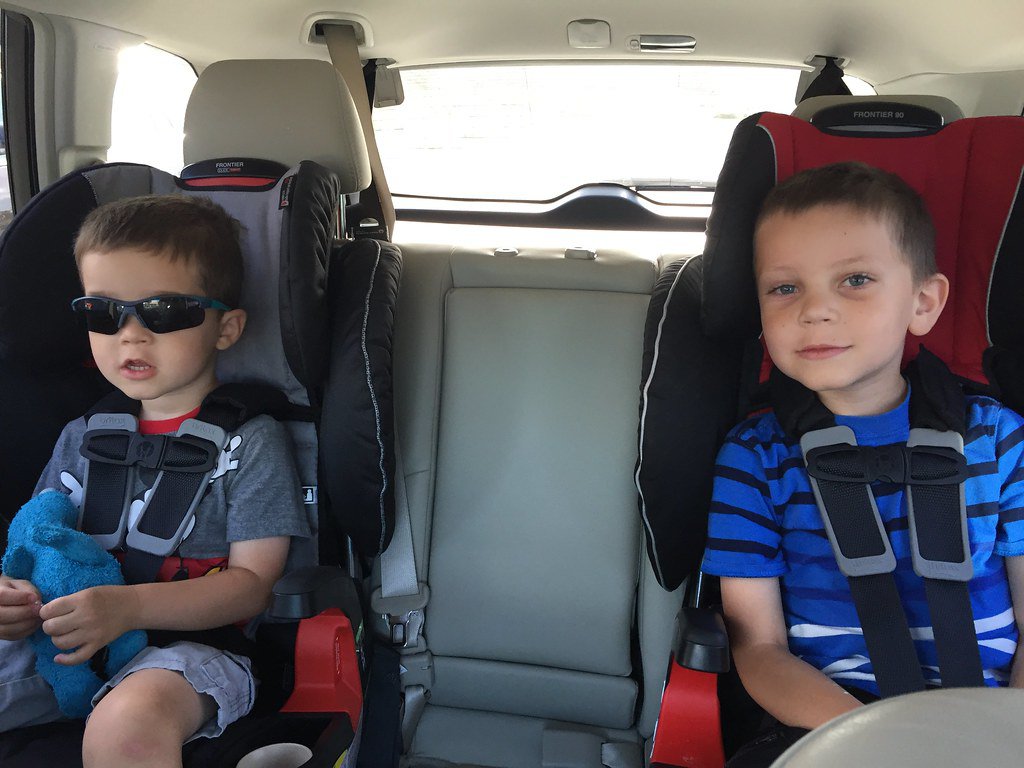You’re going to be a new parent! Congrats! Now, it is time for you to search for the best baby car seat you can afford that will ensure your child’s safety and comfort during car rides. You will need this product right from the start when you’ll take your infant home from the clinic.
Moreover, you’ll keep using a seat for your kid until he or she reaches the age of 9-10 years old. All car seat models need to meet legalized safety standards required by federal law.
Still, opting for the most expensive model on the market doesn’t guarantee you the best product out there. In my humble opinion, you should choose a midpriced seat that has several important features that you’re about to discover in the following sections.
Table of Contents
- 1 1. Choose the Right Car Seat Model
- 2 2. Evaluate the Quality of the Car Seat
- 3 3. Things to Do Before Buying a Car Seat for Your Baby
- 4 4. Tips and Tricks for a Good Car Seat that Falls within Your Budget
- 5 Extra Features
- 6 How to Install a Baby Car Seat
- 7
- 8 Where Should You Install the Car Seat?
- 9 Why Shouldn’t You Purchase a Used Car Seat?
- 10 The Best Baby Car Seat Options on the Market – My Personal Recommendations
- 11 Final Thoughts
1. Choose the Right Car Seat Model
There are different models and variations of car seats, depending on how old your baby is. There are special ones made for infants and different kinds of seats designed for toddlers. I will present and detail each and every single type so that you align the model with your child’s needs.
a. Infant Car Seats
Most new parents decide to buy this type of seat which is installed rear-facing while also having a removable carrier. The carrier must be connected to the base part which remains fixed in the car at all times. This kind of seat is the best one for newborns or smaller babies.
In other words, children who weigh between 4 and 40 pounds will fit into this seat perfectly. However, many kids will most likely become too tall for this car seat after a while. Ideally, kids below the age of 2 can be safely placed in these seats while traveling. One of the most important aspects of infant car seats is their high level of convenience provided by their detachable carrier. This way, you can get your newborn in and out of your vehicle without disturbing his or her sleep.
Price: the cost of an infant car seat can vary between $80 and over $500, depending on the model.
- Graco Snugride Click Connect 35: A Real Mom Review [2022]
- Chicco KeyFit 35 vs Chicco KeyFit 30 [2022 Comparison]
- Britax B Safe 35 vs Elite: Which Infant Car Seat is Better?
- Best Britax Car Seats Guide
- Safety First: The Full Cybex Aton Q Car Seat Review
- Chicco KeyFit 30 vs Chicco Fit2 [2022]
- Chicco KeyFit 30 vs UPPAbaby Mesa: Which One is Better?
- Nuna Pipa vs Nuna Pipa Lite – Which is Best?
- Nuna Rava Review
- The Ultimate Guide to the Best Graco Infant Car Seats
- Evenflo SafeMax Review: Will You Love This Seat?
- Chicco KeyFit 35 Review: How Good Is This New Car Seat?
- Nuna Pipa vs UPPAbaby Mesa: Which One Is the Best Pick?
- The Best Infant Car Seats for Small Cars That You’ll Love
b. Convertible Car Seats
Once your kid outgrows the infant car seat, you will need to purchase a convertible model. Experts’ suggestion is to buy a convertible seat once the baby turns 1 year old. Unlike the infant seat, this one can be placed both rear-facing and forward-facing.
The harness system, on the other hand, is pretty similar to the one of an infant seat. Furthermore, convertible seats should only be installed to face forward for kids that are at least one year old. Most convertible car seats can safely hold toddlers who weigh up to 65 pounds.
It doesn’t come with a detachable carrier and it is not a good choice for smaller babies. Still, this type of seat will help you save money because it can be used for a longer time. Price: the cost of a convertible car seat ranges between $40 and over $400, based on its features. Check out some of the most popular convertible car seat models:
- Evenflo Symphony DLX All-In-One Car Seat vs Safety 1st Grow And Go 3-In-1 Convertible Car Seat
- Britax Advocate vs Boulevard
- Nuna Rava vs Maxi Cosi Pria 85 – Which Convertible Car Seat Is Best?
- Graco 4Ever vs Graco Extend2Fit [2022]
- Graco 4ever vs Chicco NextFit Compared
- Graco 4Ever 4-in-1 vs. Britax Boulevard ClickTight Convertible Seat – Which Is Better?
- Top 5 Best Convertible Car Seats – Convertible Car Seat Buying Guide
- Nuna Rava vs Graco 4Ever – Which One is Better?
- Graco SlimFit vs Graco 4Ever – Features, Pros and Cons
- Clek Foonf Convertible Car Seat Review That You’ll Love!
- Britax Boulevard vs Marathon [2022]: Which is Right For You?
- Safety 1st Alpha Omega Elite Convertible Car Seat Review
- Britax Roundabout vs Britax Marathon Car Seat: Which is Best for Your Child?
- Britax Emblem vs Britax Allegiance – What Are The Differences?
- Graco 4ever vs Britax Marathon – Which Child Safe Seat Should You Purchase?
- The Easy Choice: A Graco Nautilus 65 3-in-1 Review
- Graco Nautilus 65 vs Nautilus 80 Elite: Which is Better?
- The Chicco NextFit Zip Review That You’ll Love
- Chicco NextFit vs Graco Extend2Fit – Which is the Best Convertible Car Seat?
- Britax Marathon vs Advocate [2022]: Which is Better?
- Chicco NextFit vs Britax Advocate Compared
- Graco My Ride 65 LX Convertible Car Seat
- The Cosco Mighty Fit 65 Review [2022]: Is it Right for You?
- Cosco APT 50 Review: Is This the Carseat for You?
- Cybex Sirona M SensorSafe 2.0 vs. Maxi-Cosi Pria 70 Convertible Car Seat
- Graco 4Ever Car Seat: Yay or Nay? Find out here!
- Safety 1st Grow And Go Review: Is This the Car Seat for You?
- Best Convertible Car Seats Guide
- The Safety 1st Guide 65 Review: Is This The Car Seat You’ll Love?
- Graco Milestone Review: Is This The Car Seat You Had In Mind?
- Cybex Sirona M SensorSafe 2.0 vs. Maxi-Cosi Pria 70 Convertible Car Seat
- The Graco Extend2Fit Review [2022]: Worth the Money?
- Graco 4Ever Extend2Fit vs Graco Platinum: Which Is Better?
- Recaro ProRide Convertible Car Seat Review
- Britax Frontier vs Britax Pinnacle – Which Convertible Car Seat is Best?
- Eddie Bauer XRS 65 Convertible Car Seat: Is This the Only One You’ll Need?
c. Booster Seats
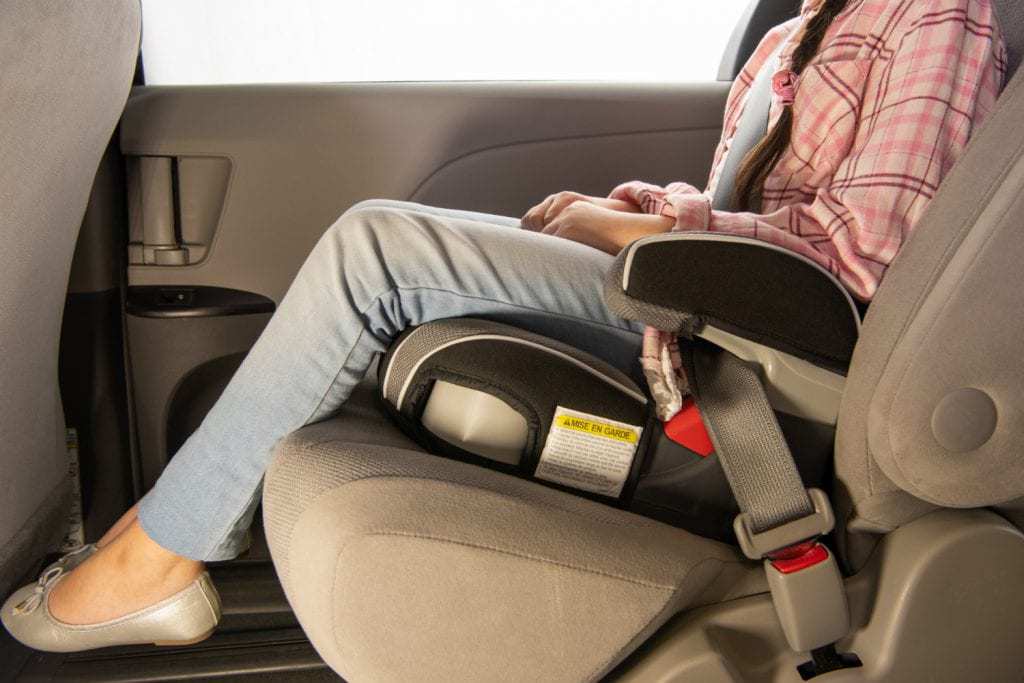
Booster seats allow your baby to sit in a more lifted and upright position. This means that you can use your car’s seatbelt system instead of the baby seat’s harness. There are two major booster seat models: the ones with a high back and the backless versions. Some brands provide booster seats that can function either way. Some people prefer the backless seats due to their lower price tag, lightweight, and portability.
Nevertheless, the high-back models ensure a safer ride because they allow the car’s seatbelt system to position a lot better. Another thing I like about high-back seats is that they offer a higher level of protection while also working as a place where your kid can rest his or her head on.
Before buying any kind of baby car seat, you should first verify your region’s laws because some states require parents to use a booster seat until their kids turn nine. Price: based on the model and its functions, a booster car seat can cost between $20 and $320. Check out some of the most popular booster seat models:
- Nuna Pipa Review
- Evenflo Chase LX Review
- Graco Atlas vs Nautilus – Which Should You Buy?
- Chicco MyFit + Booster vs Britax Frontier Clicktight | Which is Better?
- Clek Oobr Review – Is This the Safest Booster Seat Out There?
- Diono Rainier Review: Are They a Good Choice for Your Child?
- Diono Radian vs Rainier [2022]: The Diono Car Seat Battle!
- The Evenflo Maestro Booster Seat Review: Make the Safe Choice
- Clek Foonf vs Fllo Car Seat [2022]: One IS Better!
- Graco Highback Turbobooster Review [2022]: Worth the Money?
- Recaro Performance Sport Review: Combination Carseat to Love
- Evenflo Chase vs Evenflo Maestro: What’s The Difference Between the Two?
- Graco Slimfit vs Graco Milestone: Which Will You Love More?
- The Best Backless Booster Seats Your Little One Will Love
- The Best Narrow Booster Car Seat Options
- The Graco TurboBooster TakeAlong Highback Booster Review: Is It The Right One For You?
- Graco Affix Youth Booster Seat Review
d. Toddler Booster Seats
An upgraded version of the classic booster seat is the one that fits the weight and size of a toddler. These models don’t have their own harness system.
Your kid will have a lot more room to move when it comes to his or her upper body part but the toddler booster seat offers a lower level of overall protection during a car ride. Price: most of the booster seats made for toddlers are backless and their price tag ranges from $60 to over $250. Check out some of the most popular toddler booster seat models and comparisons:
- The Graco Affix vs Chicco KidFit – Which Should You Buy?
- Graco Affix Youth Booster Seat vs Highback Turbobooster Car Seat – Which is Best?
e. All-in-One Car Seats
If you want a true money-saver, then the all-in-one baby car seat is the perfect alternative. It is highly versatile and convertible which makes it the ideal fit for children that weigh from 4 pounds up to 50 lbs. rear-facing. For kids who weigh 20 to 65 pounds, the car must face forward.
If your little one weighs more than 65 pounds, you can easily use this multi-purpose model as a booster seat. It’s true these seats help you save money and time. However, they aren’t as good in all the modes as the other one-task seats mentioned above. Another drawback is their weight. Most of these types of seats are bulky and heavy which makes them difficult to handle, adjust, and install, especially if you have a smaller car. All-in-one seats are great if you don’t transport your kid very often.
Price: you will be able to find an all-in-one baby car seat for the price of $100-$300, based on the model, brand, and seller. Check out some of the most popular all-in-one car seat models:
2. Evaluate the Quality of the Car Seat
Now that you know what types of car seats the market offers, it’s time to find out some of the most important features you should look for when buying this product:
- Safety label – make sure the product comes with a special label that states whether or not the seat meets the requirements of the “Federal Motor Vehicle Safety Standard 213;”
- User ratings – check online platforms and forums to see how many stars the product you’re about to purchase has received from customers. Obviously, the best ones are those who have earned at least four stars. Usually, well-reviewed car seats are easier to use and their installation instructions are clear;
- The harness system – there are three-point and five-point harness systems. The five-point option provides maximum protection. So, choose wisely, considering your baby’s age, size, weight, and needs;
- The need to buy a new car seat – Specialists state that parents should purchase a new baby car seat instead of getting a second-hand one. Also, if, God forbids, your car has been involved in a car accident and the seat was already installed, you should verify it to see if its functions were affected.
3. Things to Do Before Buying a Car Seat for Your Baby
Know Your Baby’s Needs
Keep track of your baby’s weight and height. These two factors along with the child’s age will determine the type of car seat you need to buy. Also, this way, you will know when it’s time to upgrade to the next model. Keep in mind that any health issues or behavioral problems that your child may have will also impact your purchasing decision.
Research the Market to Find the Best Vendors
Know the stores and learn what retailers are the most serious ones. If you search long enough, you might find one that allows you to test the seat before buying it.
Another must that you need to consider is choosing a vendor that accepts returns. Brick-and-mortar retailers such as Walmart or Target sell a pretty limited range of models but you can find a larger selection of baby car seats at online sellers like Amazon, Diapers.com, and Albee Baby. Still, I believe you should always see the product in real life before ordering it.
Find Out How Your Car Works in Regards to Child-Safety Characteristics
First and foremost, you need to check whether or not your vehicle is compatible with the car seat model that you want to purchase. Find the car’s owner’s manual and study the child-safety section to discover all the relevant features you need to know like belts and seats.
For instance, older vehicles will most likely lack a LATCH which stands for lower anchors and tethers for kids. This particular system was created to enable car owners to install a baby car seat easily, without the need of using seatbelts. Last but not least, find out the dimensions of your vehicle’s backseat to see if a certain car seat model will fit.
Establish a Budget
Know how much money you want to spend on a car seat for your baby. These products can cost anywhere from $20 to more than $500. So, buying a car seat can be quite an investment. So, make sure to establish a budget and search for car seats within your desired price range.
I know what you’re thinking of: a higher price is often linked to a better and safer product. Well, you can rest assured that, in the case of baby car seats, price doesn’t really determine the quality of the product.
4. Tips and Tricks for a Good Car Seat that Falls within Your Budget
Pick a Car Seat that Your Child Can Use Until the Age of 2
The best type of car seat for your baby, if you want to save some money while also getting a pretty versatile product, is the convertible one. With this car seat, you won’t have to buy another model for the first two years of your child’s life. A convertible seat will help you save money in the long run and it is totally sound when it comes to safety.
Focus on the Product’s Most Important Features
If you want a less expensive car seat that also provides complete safety and several important features, you will have to pay a price that ranges between $80 and $200.
No matter what type of model you decide to purchase (whether it is a convertible one or an infant seat) try to opt for an alternative that comes equipped with a 5-point harness system: two waist straps, two shoulder straps, and one strap that will go between the child’s legs (all of them will meet in the middle). Other essential characteristics are:
- Being compatible with the car’s LATCH system;
- Providing side-impact protection through air pads.
More expensive car seats come with additional features like accessories, larger canopies, cushier fabric, and an anti-rebound bar.
Buy a Product that’s Easy to Clean
From personal experience, I can say that smooth fabrics are easier to clean compared to textured materials. A car seat that can be quickly wiped clean will save you a lot of time, effort, and money.
Choose a Car Seat with Clear Installation Guidelines
If you think your work’s finished right after you walk out of the retailer’s store with your new brand car seat, you’re wrong. Try to purchase a model that has installation diagrams printed on it as well as a booklet full of clear and easy-to-follow instructions. This way, you will have higher chances of placing the seat in your car in a proper manner.
Extra Features
- Additional side-impact protection pads – those are some extra foam or air pads that offer a higher level of protection and safety;
- Load leg – this features leads to improved stability and, in case of a crash, it absorbs part of the impact’s force;
- Belt lock-off – it is useful for when you only use the base part of the seat and lock it off with the car’s seatbelt;
- Height-adjustable headrest – it gives you the possibility to adjust the seat’s back part as your baby grows taller. The toddler will then have a place to rest his or her head.
How to Install a Baby Car Seat
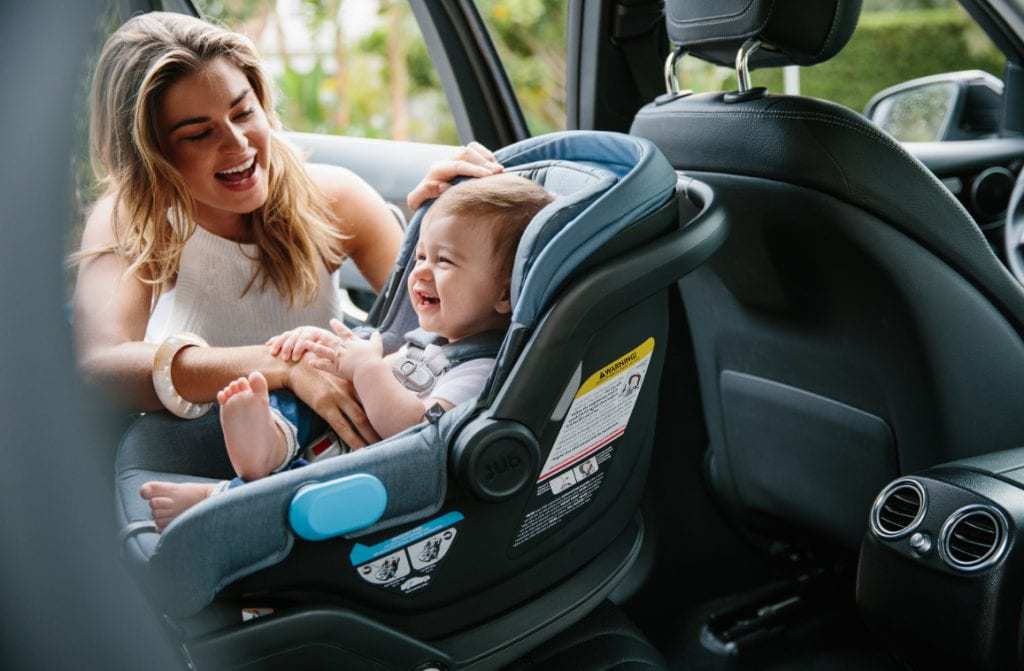
You might think that the instruction manual will be more than enough to help you figure out the proper way to install the car seat. Well, according to specialists, many people install these products in an incorrect manner. For safety’s sake, you should check the seat with a professional. You can even program an inspection with an expert from your area.
Tips on How to Install the Seat Successfully
- Carefully go through both the vehicle’s safety manual and the car seat’s instruction brochure. If the details presented there aren’t clear enough, go ahead and contact the manufacturer;
- Use the LATCH system, especially the tether, if possible. If the car seat was bought after 2002 that shouldn’t represent a problem. A car seat model that’s compatible with the LATCH system will be a lot easier to install as well as safer;
- You should seriously consider retrofitting your vehicle in case it isn’t equipped with an anchoring system. You can find out how much this process costs by asking your local auto dealership;
- Make sure you place the seat at a correct angle of recline. Forward-facing seats must be flat against the product’s back and bottom;
- A safety seat without a LATCH system should be connected to the vehicle’s seatbelt system. Moreover, the belt must be inserted through the proper slots so pull it as much as you can until there’s no slack;
- If the car seat moves more than one inch back and forth and side-to-side, you’ll have to secure it by using a locking clip which is a metal device that resembles an oversized paper clip. This tool will hold the belt or the harness system firmly in place;
- Use your body strength to push, pull, and move the car seat to see if it is secure or if it is resistant to side-to-side movements.
Where Should You Install the Car Seat?
For infants, you should always place the seat rear-facing which means that the baby will look towards the back part of the vehicle. In fact, many AAP experts say that parents should keep their kids in a rear-facing type of car seat as long as possible.
Nowadays, there are plenty of models out there that allow you to place your baby in a rear-facing position until they reach the age of 4 years old. Toddlers can also be placed in a forward-facing car seat without any risks.
Why Shouldn’t You Purchase a Used Car Seat?
You should avoid buying a secondhand car seat because of the following reasons:
- You don’t know the product’s history – it could’ve been involved in a car crash;
- Maybe it’s too old and has already expired – you must always search the details regarding the seat’s expiration date on the product’s plastic components;
- It may have cracks so keep an open eye for those potential issues;
- Maybe the model was already recalled by the manufacturer due to several possible malfunctions;
- The seat might have missing parts.
The Best Baby Car Seat Options on the Market – My Personal Recommendations
1. KeyFit 30 Car Seat for Infants by Chicco
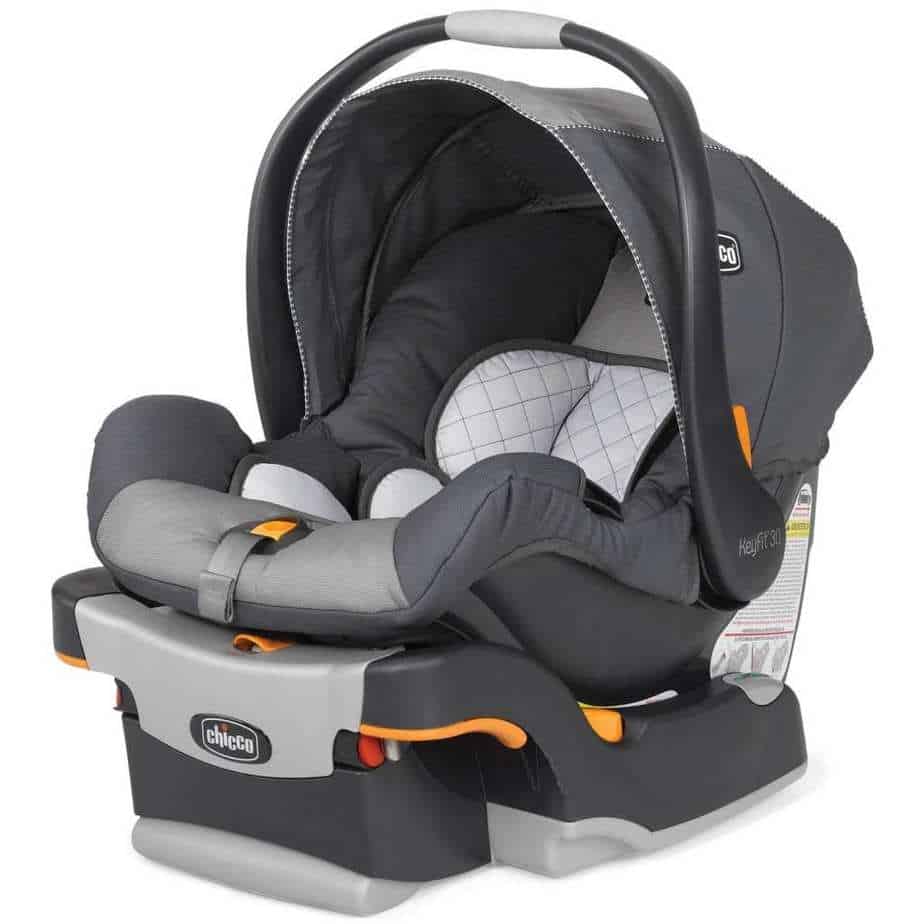
Chicco’s KeyFit 30 model is a pretty affordable infant car seat that has plenty of great safety features (such as a 5-point harness system) and it is also easy to use. The base part of the seat won’t take long to install. Moreover, the KeyFit model comes with an adapter that fits most strollers. As a drawback, this product has a pretty small canopy. User rating: 4.6/5.
Read More: Best Chicco Car Seats Guide
2. SnugRide 35 Baby Car Seat by Graco
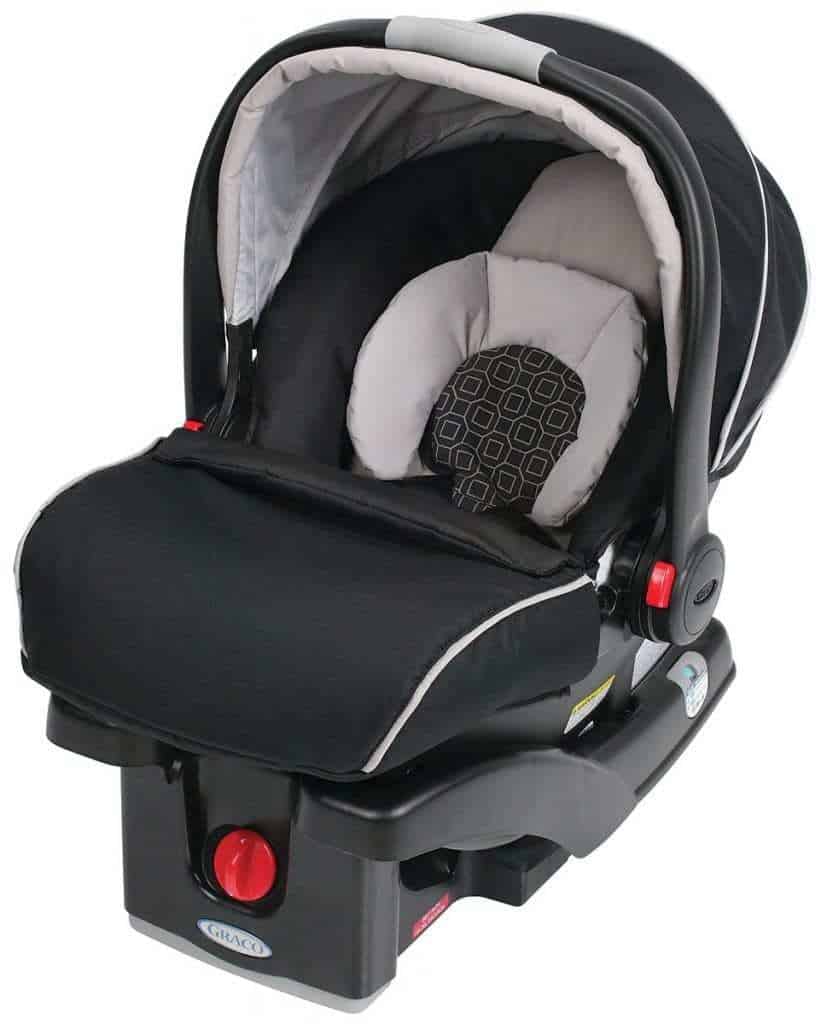
Graco’s SnugRide infant vehicle seat is lightweight and easy to transport and handle. This is another decently-priced car seat alternative that can fit kids who weight up to 35 pounds. Therefore, this seat model will last you longer. Your baby will enjoy comfortable, safe, and cozy rides.
The product even has removable head support for newborns. However, you will need to purchase an adaptor if you want to attach this product’s carrier to strollers that aren’t made by Graco. User rating: 4.3/5.
Final Thoughts
There is a wide range of baby car seat models on the market and picking the right one that falls within your budget and also meets your baby’s needs can be a pretty daunting task. No matter what you do, focus on the most essential aspects of purchasing a car seat, and don’t feel bad if you feel a bit overwhelmed because we all felt that way the first time we had to make this particular buying decision.
To conclude, there are several main aspects you must ask yourself before buying a certain car seat model for your baby:
- How old and how tall is your baby and how much does he or she weigh?
- What kind of car do you own?
- Will you be placing the car seat in other vehicles as well?
- Does your car have a LATCH system?
- Is your vehicle equipped with an under-floor storage area?
Read More:
- Baby Car Seat Recalls [2022]
- 5 Best Infant Car Seat Covers [2022]
- The Best All-In-One Car Seat Options for 2022
- Best Gender Neutral Car Seats [2022]
- Diono vs Britax Baby Brand: What Are Their Main Differences?
- The Best Protectors to Keep Messes at Bay
- How Long Are Car Seats Good For & How to Dispose Them?
- Doona Car Seat & Stroller Review: Is This The Best Deal for You?
- The Best Infant Car Seats for Small Cars That You’ll Love
- Chicco NextFit vs Britax Marathon | Which Should You Buy?
- The Best Travel Car Seats for 2022 That Every Parent Needs
- Rear Facing Car Seat Age Guide
- Best Vehicle Seat Protectors For Car Seats
- Front Facing Car Seat Age Guide
- The Best All-In-One Car Seat Options for 2022
- The Evenflo SureRide DLX Review – Safety You Can Grow With
- Clek Olli vs Ozzi: Which Car Seat Is the Best Choice?
- The Best Travel Car Seats for 2022 That Every Parent Needs
- Best Vehicle Seat Protectors for Car Seats
- Maxi Cosi Pria 70 vs 85 [2022]: Which is Best?
- Best Nuna Car Seats Guide

